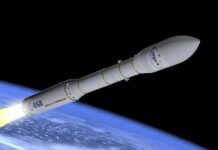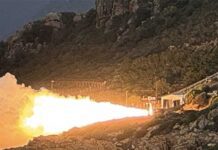
The P120 solid-fuel first stage that will power the Vega C rocket’s return-to-flight mission has been transferred to the ZLV launch pad at the Guiana Space Centre.
Following the failure of the rocket’s second flight, Vega C was grounded until an investigation could be completed. The rocket’s time on the ground was extended after a recertification hot fire ground test of the rocket’s Zefiro 40 (Z40) second stage also failed.
After Vega C rocket builders, Avio, completed a complete redesign of the Z40 second stage nozzle, the first of two recertification tests was completed successfully in May at the company’s testing facility in Sardinia, Italy. The second and final test was successfully completed on 3 October clearing the way for the rocket’s return to flight.
The cargo ship MN Toucan arrived in French Guiana on 19 September, carrying elements for the rocket’s return-to-flight mission. Once removed from the hull of the Toucan, the P120 first stage was transferred to the booster integration building (BIP) for unpacking and final preparation. On 3 October, the stage was transferred from the integration building to the VEGA launch zone (ZLV) and placed on the launch pad. The first interstage will be stacked next, followed by the recertified Z40 second stage with its redesigned nozzle.
While the rocket begins to take shape, ESA announced on 9 October that the rocket’s payload, the Sentinel-1C Earth observation satellite, had safely arrived in French Guiana.
Initially, the launch of the Vega C return-to-flight mission had been expected to take place in November. However, recent comments from ASI president Teodora Valente have suggested that it has now likely slipped to December.




